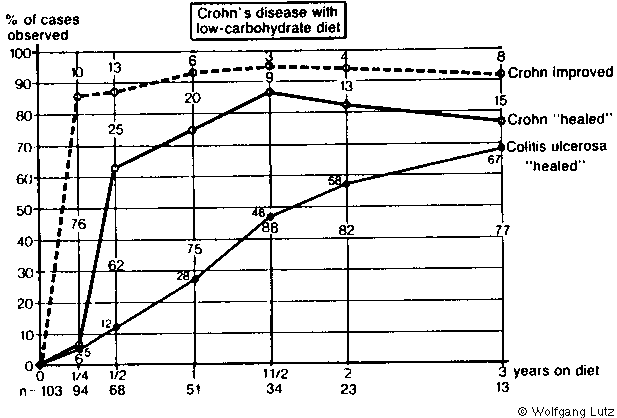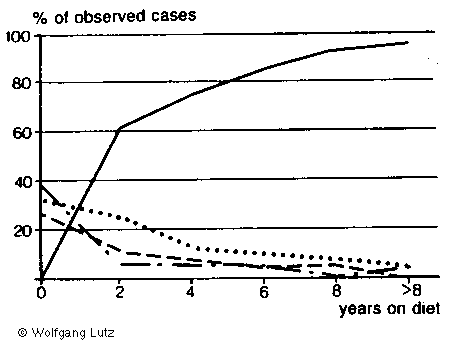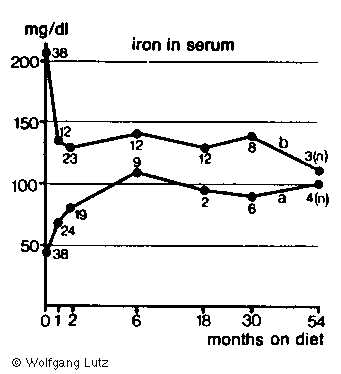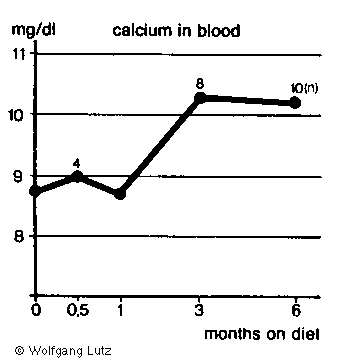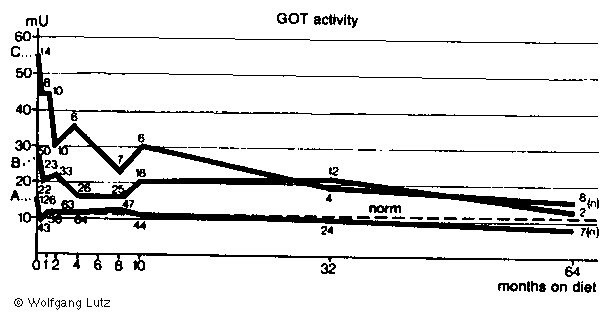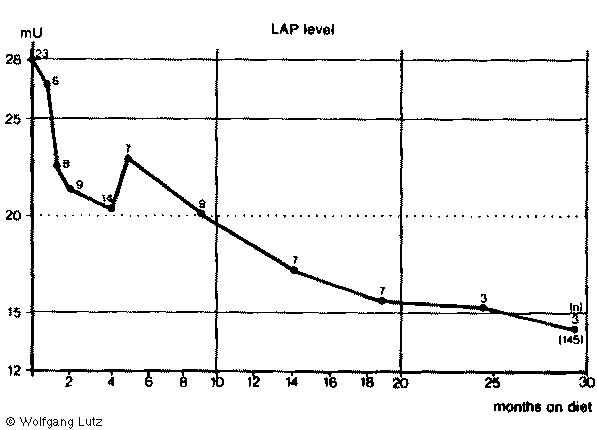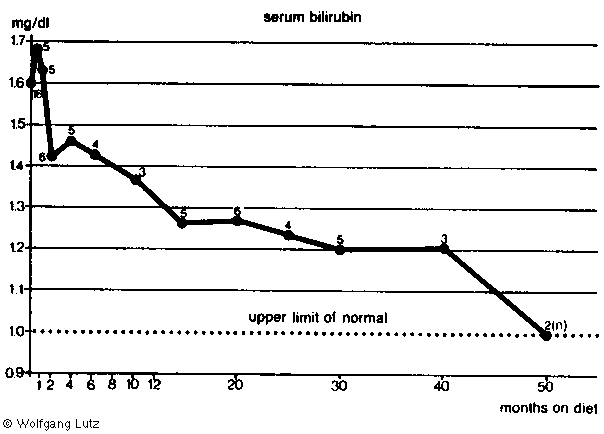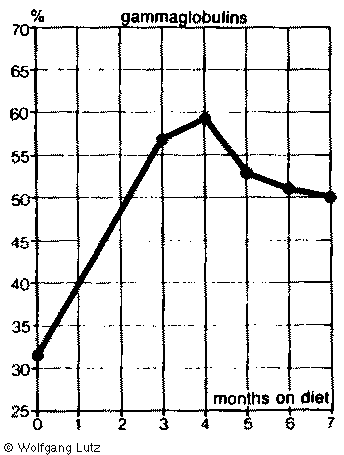|
The Role of Fat and Carbohydrates in our Diet by Dr. Med. Wolfgang Lutz ISBN 3-921500-24-9 © 1986 by Selecta-Verlag Dr. Ildar Idris GmbH & Co. KG Planegg V. Muenchen, West Germany Original title "Leben ohne Brot", translated by Beatrice Idris-Duncan and Joy Wieser. All rights reserved. No part of this text may be reproduced in any form or by any means electronic or mechanical, including photocopying, recording, or by any information storage and retrieval system, without permission in writing from the publisher.
Service to Danish readers: Danish translation of certain difficult words and medical terms
(Excerpt 2: page 125-180) Chapter VII: GASTRO-INTESTINAL TRACT To anyone holding the view that carbohydrates are un-natural and harmful components of our diet it is quite obvious that the gastrointestinal tract, being in the front line, is exposed to the most danger. The idea of introduction of a low-carbohydrate diet as a general mode of therapy for disorders of this system is therefore logical, even if contrary to what has hitherto been practiced. Although it has been recommended that refined sugar and white flour be avoided in some gastrointestinal conditions (*1-2), and gliadin-containing types of grain in another (*3-6), carbohydrates as a whole so far have not been considered as undesirable energy sources. Too Much Acid Distressing heartburn is often the first symptom to disappear following withdrawal of carbohydrates from the die However severe, and even if made worse by factors like the back-flow of gastric juice into the esophagus in hiatal hernia, the chances of success are good. If patients come back with the complaint that the diet is no longer effective and their heartburn has returned, a closer look usually reveals that some carbohydrates have again crept into the diet. Or a gastrointestinal infection cam be suspected - and treated. In some way carbohydrates appear to disturb acid regulation, i.e. the normal state of affairs in which acid is produced by the stomach only when it has something to digest. Only a sick stomach produces digestive juices when empty. This so-called 'fasting secretion' is the reason for the auto-digestion seen in gastric ulcers, or at least in ulcers near the pyloric sphincter, the duodenum or at the artificial exit of a resected stomach. Excess gastric acid is responsible for or provides the right conditions for, for development of a gastric ulcer, which is deducible from the fact that a typical gastric ulcer is found only in sites where contact with gastric juice is possible. If the stomach is resected so that no more acid can be produced a gastric ulcer is permanently cured. In rare cases, however, yet another ulcer develops even if further portions of the stomach have been removed in a second and even third operation. Surprising quantities of acidic gastric juice can be obtained from such patients by means of a stomach tube even in the absence of a test meal or any food whatsoever. Laboratory tests on such juice reveal that the fasting secretion of acid, just as in patients with a duodenal ulcer, approaches the so-called maximum secretion. By this, we mean the quantity of hydrochloric acid produced by the gastric glands when they are strongly stimulated by food or histamine. Under these circumstances the Zollinger-Ellison syndrome (*7-10), should be suspected, a condition first described many years ago by two Americans, Zollinger and Ellison. Tumors or tumor-like growths are found either in the islet organ itself or in its immediate vicinity, and can be removed surgically. Gastrointestinal Hormones In histological preparations of resected material from the above cases, cells were found closely resembling the alpha-cells of a normal islet (pancreas' Islets of Langerhans organ (*11-12). Large quantities of a substance extracted from them proved to be highly effective in causing acid secretion, and was finally identified as 'gastrin' (*13). Gastrin is the hormone responsible for gastric secretion. Although not the sole agent eliciting acid secretion it is certainly the most important. I do not intend to go into the physiology of gastric secretion in detail since it would take us too far from our main theme. However, it should be mentioned that apart from nervous influences, which for example cause our mouths to water at the sight or smell of food, or even at the sound of the dinner gong, it is gastrin which sets off the flow of gastric juice at meal-times (*14-15). The substance is produced at the base of the mucous glands of the pylorus when the latter is in contact with food. It enters the blood stream and thus arrives at the glands in the stomach's body where hydrochloric acid and protein-splitting enzymes (pepsin, cathepsin) are produced, and where it can directly and indirectly influence the stomach movements, particularly the emptying mechanism. Thus the stomach is provided with a kind of self-regulating mechanism. Gastrin is formed when food enters, and this leads to secretion of the enzymes and hydrochloric acid necessary for digestion in the stomach. When the stomach contents have been sufficiently acidified the sphincter opens and the acid contents enter the duodenum. Here substances are produced (secretin, cholecystokinin, and enterogastrin for fatty foods) which stimulate the activity of the pancreas and also affect the neutralization of the acid from the stomach, at the same time arresting the efflux of further acidic stomach contents. The important point to note is that too much gastrin is produced in all cases of hyperacidity, in gastric ulcers and particularly duodenal ulcers, and in extreme quantities in the Zollinger-Ellison syndrome. But this gastrin arises in the pancreas and not in the stomach (*13), (*16-23). In recent years the so-called Verner-Morrison (*24-29), syndrome has been considered to be a mirror image of the Zollinger-Ellison syndrome. The former is associated with diarrhoea, low potassium levels in the blood, and with a deficiency in free gastric acid. Small tumors contain abnormally-large amounts of secretin (a hormone similar to gastrin but with a different effect) may be found in the pancreas. The two syndromes, however, are not sharply distinguishable from one another as this description would suggest. The symptoms can occur in a variety of combinations, and may be accompanied by disturbances of a diabetic type such as elevated blood sugar or too little sugar (hypos), just as in the case of tumors of the beta-cells. The patients often complain of headaches and hot flushes in connection with eating, and in fact at such times it is possible to detect abnormally-high amounts of serotonin in the blood and urine. The serotonin is a hormone believed to be formed in the so-called light cells of the islet organ of the pancreas. Some investigators consider them the source of all Islet cells (*30-33). The Pancreatic Duct Syndrome In order to understand how the activity of the various segments of the gastrointestinal tract is controlled we have to go back to what we said earlier about neurosecretion in connection with the hypophysis. The nerve cells of the hypothalamus secrete polypeptide substances which reach the hypophysis via small blood vessels and are then either released into the blood when needed, or stimulate the hypophysis itself to produce protein hormones such as the gonadotropins, ACTH, human growth hormone, thyrotropic hormone, etc. The closer we delve into the problem of neurosecretion the clearer it becomes that it is not confined to the hypothalamus and hypophysis but is in fact a widespread phenomenon. Communication between nerve cells is effected by means of chemical substances known as neurotransmitters. In this way one nerve cell can contact another, its messages can be conveyed either within an organ by means of peptide hormones, or over larger distances by means of the proteohormones which are produced in certain endocrine organs at the behest of peptide hormones. The gastrointestinal tract seems to be especially influenced by peptide hormones formed on the spot by neurosecretion. The neurosecretory centre is situated in the pancreas in round, glandular structures termed "islets" (of Langerhans), which apparently secrete insulin directly into the blood since there is no sign of effluent ducts. Insulin is an antagonist of glucagon. The large number of different types of cells in the islets would suggest that they form still other, as yet unrecognized, incretions. In addition to the hormones of the pancreas a larger number of more or less well-known polypeptides with their own regulatory functions is produced in the stomach and intestine. Gastrin is one of them, and although normally produced in the cells of the stomach and reaching its target organ, the gastric mucosa, via the blood stream, it can under certain circumstances also be produced in the small intestine and in the islets of the pancreas. As has already been mentioned, the islets are also the source of secretion. Since the development of a highly sensitive method for detecting polypeptides, the RIA or Radio Immune Assays, more of this group of substances have been discovered. They are apparently concerned with governing the activity of the gastrointestinal tract and its glands, and include cholecystokinin or pancreokinin, enteroglucagon (an insulin antagonist like pancreatic glucagon), and the gastroinhibitory polypeptide (GIP) from the duodenum and upper small intestine, which is chemically very similar to secretin and glucagon. GIP inhibits the formation of gastric acid and promotes insulin production in carbohydrate digestion, and is thus insulinotropic. It has already been mentioned as representing the probable starting point of diabetes and the reason for hyper-insulinism in carbohydrate eaters. Yet another gastrointestinal hormone is the so-called Vasoactive Intestinal Polypeptide (VIP). It leads to hot flushes and diarrhoea if produced in excessive amounts. Originally, i.e. in primitive forms of life, the entire gastrointestinal tract was probably able to produce these regulatory polypeptides. In the course of further developments, however, the various parts took on a specialized function. Esophagus, stomach, duodenum, small and large intestine, differ not only in structure but also in function, so as to serve the body in the best possible way. In the course of this transition glandular organs have fused, in order to produce the liver and pancreas, whose only present connection with the intestine is via the ducts through which their secretions enter its lumen. As has already been mentioned, the neurosecretory portion of the pancreas is concentrated in the islets. Neurosecretion is nevertheless not confined to the pancreas and its islet organ, but still plays a role over the whole of the gastrointestinal tract. Even though insulin and glucagon are apparently produced exclusively in the islets the other gastrointestinal hormones can be produced elsewhere too, like gastrin, at least under pathological conditions. In the embryo the primitive pancreatic duct from which the pancreas develops appears to harbour the primitive form of every kind of cell producing gastrointestinal hormones. With this in mind I suggested the term "pancreatic duct syndrome" for all disorders triggered by gastrointestinal peptides. The cells producing gastrointestinal hormones can be thought of as belonging to a clan dating back to primitive times. Some members of the clan have built larger houses (the islets of the pancreas) whereas others still live in the open or in very primitive shelters. Nonetheless the clan sticks together through thick and thin, and their sense of loyalty is such that if one of the members is injured, an outcry will be heard from the rest. Emanation or irradiation is a familiar idea to members of the medical profession. Apparently a strong stimulus to one gastrointestinal polypeptide or to its site of production involves to greater or lesser extent all of the others. Not only is insulin or glucagon produced, but gastrin, secretin, serotonin, GIP, VIP, as well, and probably others as yet unrecognized. That the disturbances already discussed are due to the carbohydrates in the diet, and that they disappear if carbohydrates are restricted, is probably due to the fact that the two chief hormones of the islet organ, insulin and glucagon, primarily regulate carbohydrate metabolism. They respond to too much or too little blood sugar, and the presence of carbohydrates in the intestine. And least one of the gastrointestinal polypeptides (GIP, VIP) has an insulinotropic action. It was previously assumed that sugar injected direct into the blood necessarily has a greater effect than the same quantity administered orally. Surprisingly, the opposite holds true and sugar in fact is much more effective if it enters the body via the intestines, i.e. insulin production is stepped up much more rapidly and is more persistent than if the sugar is given intravenously. The reason for this is I think that when sugar enters the intestine insulinotropic substances are produced the mucosa and as their name suggests they stimulate the pancreas to produce insulin. They are the outposts which serve to warn the headquarters that sugar is on its way, and that insulin has to be produced for its breakdown. It might be that these outposts represent the seat of our civilIzation diseases (see also chapter XIII). Our primitive ancestors learned to live without carbohydrate over the course of millions of years and now our body, via the above-mentioned outposts, reacts "allergically" to the kind of food that was introduced with grain cultivation, and even more to the large quantities of sugar that we have consumed since the development of sugar-beet cultivation. The 'clan' reacts as to an enemy against which it is in fact no longer armed. It throws in all the resources at its command even if the weapons involved are not suited to the purpose. The body produces not only insulin and glucagon but secretin, pancreozymin, vasoactive intestinal polypeptides, and above all gastrin as well. Like a beleaguered garrison it finally resorts to producing ammunition in workshops originally intended for quite different purposes. Similarly, as a result of prolonged excessive intake of carbohydrates, gastrin is finally produced by the pancreas as well as by the stomach. That this somehow describes the situation is clearly borne out by the observation that all symptoms connected with the pancreatic-duct syndrome disappear upon withdrawal of carbohydrates from the diet. Although I have not yet had the opportunity to put my idea into practice I am convinced that the Zollinger-Ellison syndrome would, if not the result of a malignant tumor, eventually respond to a low-carbohydrate diet if continued long enough, just as does Morbus Cushing. There is little doubt that in addition to GIP or VIP the typical fluctuations in the blood-sugar level and the attendant counter-regulation so typical or carbohydrate consumers play a special role. This was discussed in the chapter on diabetes and hypoglycemia. It is striking that in cases of hyperacidity and duodenal ulcer the maximum acid production in connection with eating is the same as in normal subjects, whereas the so-called basal secretion in the fasting state is higher than normal. And it is in this fasting state that the tendency to hypoglycemia becomes manifest, with its resultant need for increased glucagon (and gastrin) production. HIstological similarities between the gastrin-producing cells in tumours from Zollinger-Ellison patients and the glucagon-producing alpha-cells of the islet organ support this theory. Viewed in the light of such observations it would appear that gastric surgery is being performed in the wrong place. The removal of the lower part of the stomach (antrum) deprives the organism of a gastrin production geared to the requirements of the digestive tract, whilst leaving the cells that are active between meals to produce the fasting secretion and ulcers. I am convinced that we would spare many of our patients the need of undergoing surgery if we were to put them on a low-carbohydrate diet. An operation is, after all, only a form of mutilation leaving the root of the trouble untouched. Gastritis, Enteritis, Ulcers The above ideas have been fully confirmed by my experience on the effect of a low-carbohydrate diet in patients with hyperacidity and duodenal ulcers. Both gastritis and ulcers heal if carbohydrates are restricted. A so-called callous gastric ulcer, however, should not be treated immediately by simple restriction of carbohydrates. These ulcers are stress-induced and a transition to a new diet entails further stress. Therefore one has to give small amounts of cortisol first until the ulcer has healed and then slowly introduce a low-carbohydrate diet. In my experience the only permanent relief for an ulcer lies in consistent adherence to a low-carbohydrate diet. Lack of discipline in this respect usually leads to the operating table. The frequent mention of ulcers in connection with gastro-intestinal disorders does not necessarily mean the condition is as commonly encountered in a physician's practice as in a hospital, where there is simply an accumulation of cases that cannot be treated at home. Even the duodenal ulcer is a relatively rare condition, at any rate less common than gastritis, enteritis and colitis. It was originally believed that mucosal irritations could be detected by means of an X-ray. More recently, however, biopsy methods have been developed in which small pieces of mucosa are removed from the stomach or intestine. Their histological examination has provided us with more detailed knowledge as well as some surprises. We know that the story begins with excessive irritation of the mucosa and increased production of gastric acid and digestive enzymes. At this stage the mucosa presents a fairly normal aspect under the microscope. X-ray pictures show the so-called fasting secretion, i.e. even an 'empty' stomach, is full of juice. The mucosal folds are either normal or swollen, indicating that adequate substance is still available. That this type of gastritis represents the initial stages of the disease and is not another variation of it is demonstrated by the observation that it is the common form in children and young subjects where the disorder is not long-standing. X-ray pictures of children with gastritis almost invariably reveal normal or enlarged mucosal folds and a copious fasting secretion. The longer the process has time to develop the less fasting secretion is seen. The sphincter is open and the stomach is seen to empty its contents prematurely into the small intestine. In the end, what was initially an excess of gastric acid and pepsin is now too little and in some cases NO gastric acid can be demonstrated at all. An experienced eye recognizes this in an X-ray picture, but it becomes very obvious in pieces of mucosa examined under the microscope that atrophy of the mucosal layers has set in and large numbers of mucosal cells have perished. Heartburn and other symptoms of hyperacidity should not be allowed to mislead one. Even with such a thin mucosa the stomach can still produce acid in quantities sufficient to cause a severe burning sensation in the lower oesophagus, whereas the normal stomach moves its contents in a downward direction (except in vomiting), a diseased stomach can in some cases regurgitate its contents into the oesophagus. The mucosal atrophy, whether due to chronic damage, or --- as mentioned earlier --- to excessive secretin (GIP, VIP) production which might to be responsible for the deficiency of acid, leads to a series of consequences for the digestive apparatus. Raw connective tissue, in the absence of adequate amounts of acid or pepsin, is insufficiently broken down and even the juices from the liver and pancreas in the small intestine are unable to complete the process. Such patients often suffer from diarrhoea if they eat raw or smoked meat. This is no great misfortune and the patient can easily avoid such foods if made aware of the necessity. The deficiency of acid, however, results in malfunction of the emptying mechanism of the stomach. Normally the gastric sphincter shuts as soon as the acid content in the duodenum rises. In this manner the passage of further acid contents is delayed until the acid has been neutralized by the alkaline juices of the duodenum (bile and pancreatic juice). If the stomach produces too little acid the point of neutralization is reached sooner, with the result that it empties too rapidly. The stomach thus loses its function as a depot and the rest of the digestive tract is overburdened by receiving insufficiently-digested food. But breakdown of food is not the only function of the stomach. For example, it produces a substance, the Intrinsic Factor, which by combining with vitamin B-12 (Cobalamine) in the food, and perhaps with other so far unknown substances, renders it absorbable. If the mucosa is atrophic and unable to form intrinsic factor, the vitamin is not absorbed but is lost in the stool. Since vitamin B12 is essential for growth of the entire organism as well as for maturation of the red blood corpuscles it is understandable that patients of this type suffer from a variety of disorders including pernicious anaemia. Although no-one believes today that gastritis and enteritis are expressions of bacterial or viral irritations, we still have no exact idea as the cause of these common complaints. In my opinion we are dealing with nutritional diseases provoked by the high carbohydrate content of the diet of civilized man. Carbohydrates elicit production of gastrin, secretin and so on, and in the initial stages the mucosa is stimulated to produce excessive quantities of digestive enzymes, and this at the wrong time, until finally it succumbs. The process is enhanced by the tendency to tissue deterioration seen in carbohydrate-eaters. Every organ has to make a contribution to the toll of protein that is constantly demanded of carbohydrate-eaters by the mechanism of the adrenocortical hormone. The process is the same as that already discussed in connection with the striae. I have described these processes in detail because their understanding is of vital importance in treating such patients. The more recent the process the earlier the patient comes for treatment, the more fasting secretion, enlarged mucosal folds and other signs of mucosal swelling and hyperacidity, the sooner can the patient expect to be relieved of his complaint by means of a low-carbohydrate diet. The better-established the process, the thinner the mucosa and the more rapid the stomach emptying the longer it takes to effect a cure, and in some cases the less complete will this cure be. But an improvement can be expected in any case. Chronic inflammation of the stomach (gastritis), the duodenum and small intestine (enteritis), and large intestine (colitis), often occur together, although in most cases the symptoms of one or another of the organs or hormones of the pancreatic duct system usually dominate the picture. The characteristic symptoms of gastritis are a feeling of sickness, nausea and vomiting in the fasting state, usually tine morning and following breakfast, choking, a lump in the throat and a burning sensation the stomach. Fasting pains that are usually improved by food to return as after-pains a couple of hours later suggest disease of the gastric pylorus or duodenum. Enteritis is usually accompanied by a full feeling after meals, rumblings. gas, inability to digest fats and colicky stomach pains. Fat is not the Culprit Because fat in the diet evokes unpleasant symptoms in many patients, the opinion has arisen that a gastric diet has to be low in fat. But a low-fat diet never brings about a cure. In fact the diet that I recommend for patients can later include large quantities of fat. The patients feel distinctly better even within a few days and usually are completely well again within a couple weeks. But if they attempt to eat carbohydrates they quickly notice that these were responsible for the discomfort and not the fat or other foods. In very severe cases of enteritis the small intestinal loops are knotted and swollen, and the patients have a pot-belly similar to that seen in primitive peoples whose diet consists mainly of carbohydrates. The children often already suffer from Kwashiorkor, a disease characterized by a state of malnutrition, swollen belly and oedema, and resulting from their one-sided, low-protein diet. Even in civilized countries we find equivalents to this disease in which, for unknown reasons, dietary fat cannot be utilized but is eliminated in the stool. A typical disorder of this kind is celiac disease in infants which results from oversensitivity to the protein gliadin (*3-5), a substance present in wheat, rye, barley and oats. Since corn, rice and potatoes contain none of it, it is quite a simple matter to rear the patients on a gliadin-free diet and at the same time ensure their normal development. The absence of the necessary enzyme for splitting gliadin from the intestinal villi suggests that the gliadin sensitivity is of genetic or immunological origin. A gliadin-sensitive type of enteritis is also encountered in adults in the condition known as endemic (as opposed to tropical) sprue (*5). In this disorder, as in other forms of chronic enteritis, not only can antibodies to gliadin or its individual fractions (e.g. fraction III) be demonstrated, but also antibodies to hens' eggs, milk, and even to rabbit protein (*34-36). It can hardly be assumed that the defect is of genetic origin in these patients but rather that the damaged mucosa permits the passage of antigens which elicit the production of antibodies in the blood. This would mean that the mucosal damage represents the first step in the disease and can thus be regarded as the cause and not the effect of auto-immunization. Itching (Pruritus) I have another reason for believing that this is indeed the situation. A large number of patients visit the doctor on account of itching, which they report as occurring after wetting of the skin (bathing or sweating), and also after eating certain food. If these patients are put onto a low-carbohydrate diet the itching usually disappears after a couple of months. My explanation is that the diet gives the intestine a chance to heal, the mucosa recovers and no longer lets through (or completely breaks down) the food constituents that could previously enter the blood and elicit an allergy. Since I have been so much concerned with the clinic and radiological signs of enteritis I have come to realize just how many apparently clinically healthy patients suffer in this way. Only when closely questioned do they admit their discomfort, and for this reason the argument that such antibodies are found in 'healthy' subjects and has nothing to do with enteritis does not hold water. It is small wonder that the gliadin-free diet automatically prescribed for adult enteritis is not particularly successful. When the condition due to low-carbohydrate has improved to the point where the patients can safely begin to add again some carbohydrate to their diet it is bread and other flour-containing foods that are least-well tolerated. I believe that this is not because gliadin is responsible for the enteritis but because it has a greater allergic effect than other unsplit proteins if it gets into the blood. Therefore bread Is forbidden to such patients. They may replace the carbohydrate with fruits, vegetables, potatoes and pulses. The fact that carbohydrates have something to do with gastro-intestinal ailments was already known to Prof. H. Lampert, who recommended restricted carbohydrate intake for the so-called fermentation dyspepsia (when stools are acidic and smell peculiarly acidulous), and for abdominal flatulence (*36). Had he continued on this path, he surely would have observed that not only "fermentation dyspepsia" but also "putrescent dyspepsia" responds to carbohydrate restriction. For the latter disorder he recommended other diets. Colon Disorders Constipation On the whole, constipation is the most common illness of the colon, but it is mostly restricted to the female gender since the female hollow organs, which include the uterus, tend to retain their contents in order to preserve the fetus, instead of expelling them. Therefore women are also more susceptible to enervation and infections of the urinary tract, but less susceptible to ureteric colics. Without laxatives the stool of chronically constipated patients is broken down by putrefaction bacteria. The gases produced during this process can he taken up by the blood and detoxified in the liver. Or the tormented gut finally rids itself of the stools by the so-called paradox diarrhoea. Billions of dollars are realized by producers of laxatives but the ailment is treated only very superficially. Experience shows that the effect of laxatives diminishes with time so that the dosage has to be increased or the preparation has to be changed. In the long run they are most likely health-detrimental since they cause an evacuation of the bowel by irritating it, and because they have been demonstrated to disturb the mineral metabolism (loss of potassium). This constant irritation of the mucosa finally leads to the most predominant complaint among chronically constipated patient: they feel constipated although their colon is totally empty and laxatives would not be necessary. When these patients come to the physician, he justly recommends the discontinuation of the medication. But without laxatives the patients have no stool. If they are put on a low-carbohydrate diet then they definitely have no evacuation. Now the last motivating force for the bowel abolished because the fermentation process stops and the entire gastro-intestinal tract calms down. Even the female patients who are not normally constipated react to a low-carbohydrate diet with an indolent bowel. That is why I have not initially treated constipation with this diet. However, over the years I solved this problem by instructing my patients to continue the laxatives and by prescribing them instead daily cleansing enema with one and a half litres of warm water without additives in order to bridge the period of initial change for the worse. Under the continued diet, sooner or later the stool will normalize. In children it can take one or two days, in young adults one or two weeks, and in older persons a few months, but undoubtedly it will be successful sooner or later. Diverticulosis The wall of the colon consists of several muscle 1 which cross each other and, like a lattice, leave open spaces through which blood vessels and nerves pass. When these muscle layers weaken, the spaces enlarge to the point that mucosa can protrude through the meshwork. These finger-like mucosa protrusions get under the peritoneum, which covers most of the colon and becomes deformed into button shapes. These "buttons" are covered by peritoneum on the outside and are therefore fixed in place so that they can no longer retract. On the inside they contain stool or other bowel contents. The number of these so-called diverticula can vary greatly. There are patients with one or two diverticula and others with 20 to 50. They generally do not cause typical symptoms. Only when they become inflamed does the resulting peritonitis create problems; at times it necessitates immediate surgery. The diverticula are most-commonly localized in an area of the large bowel called the pelvic colon, an S-shaped loop between the rectum and descending colon on the left side. Here an inflammation creates symptoms like an like an appendicitis would be on the right. Usually a diet rich in fibers is recommended for the treatment of diverticulosis because years ago scientists observed that African Negroes who eat fiber-rich diets have no diverticulosis and also get few other colon diseases (cancer). I, however, do not believe in this fiber hypothesis which has become very popular over the last few years. Man is a hunter and gatherer and not a herbivore. although his original diet may have contained somewhat more-undigestable food residues. Therefore, I also treat diverticulosis with a low-carbohydrate diet very successfully. Here the prevention of an initial constipation through the regular application of cleansing enemas as described in the previous chapter on constipation is particularly important. After a few months the patients will have normal stools and no further complaints relating to their diverticulosis. The existing diverticula will not disappear but no new ones will form. Most of all, the inflammation, which very often exists in the gastro-intestinal canal of consumers of normal diets, and which spreads to the diverticula, will heal. Finally, the bowel musculature will strengthen and the original cause of the diverticula, namely the muscular weakness with the enlarged spaces between the bundles, disappears. Diarrhoea I am not talking about the short periods of liquid stool which occur several times a year due to infections with various bacteria or viruses. Particularly viruses multiply in the gut, enter the blood stream, and finally lead to a general illness. A frequent traveller knows that "Montezuma's Revenge" is not restricted to Mexico. On long trips one enters regions with unfamiliar germs to which one is not yet resistant and promptly becomes ill. Here I mean the chronic diarrhoea, which is much more common than is generally assumed. One just has to visit larger toilet facilities in a restaurant or train station to hear the familiar noise in one of the neighboring stalls. However, this illness is evaluated differently by various people. Some have had diarrhoea for years and have become so used to it that they do not perceive their condition as unusual anymore. I remember one patient, the foreman of a Mercedes-Re service station, who came to me years ago and told me that he has had diarrhoea for over 15 years now and that he had consulted at least ten physicians without any success. He did not dare to leave his house anymore; when he had to out anyway, he would immediately look for a rest stop since at times he could hold his stool not even for one minute. I prescribed him a low-carbohydrate diet and told him to see me again in a fortnight, because I was sure that the problem would have resolved by then. This was indeed the case. He came, thanked me and told me that of the many doctors he consulted previously, not one knew how to help him. He did not quite understand that, because if there is mechanical trouble with one the Mercedes-Benz models, all service stations in the whole world would be informed and instructed how to repair the defect. Whether this was not so in medicine? No, I had to admit: we have the so-called scholarly medicine with certain dogmatic views, and other views are not tolerated. The many "outsiders" among the medical scientists will surely agree with me wholeheartedly. When chronic constipation is to be understood as disturbed motility of the bowel due to an insufficiently-developed colon musculature, which is unable to move its contents ahead (which Is hardly the heart of the problem), then chronic diarrhoea surely cannot be considered solely as motility disturbance. Rather, the bowel evacuates because it does not want to contain tts contents; it is not able to absorb water and to produce stool of a normal consistency; therefore it releases the contents of the small intestine in a more or less unaltered form. In my experience, acute diarrhoea is followed by a lengthy period of liquid or soft stool, although through therapy and the elapsed time interval the Infectious organism has been killed off and the Infection has been overcome. Furthermore, this type of diarrhoea can be halted by giving gold or cortisone for several days, i.e. by subduing the immune reaction; therefore we are dealing here with a so-called "auto-aggressive disease". For reasons which are not yet known in detail, the body starts to mount an immune reaction not only against the infectious organisms but also against the affected organ. I got the Impression that initially this mechanism does not necessarily have to be considered morbid, that the attack against the affected organ is part of the immune reaction itself. The body tries not only to fight the infectious organism, but also to destroy its basis for existence, the affected organ, by weakening it with its defensive forces. One can hardly understand the multitude of existing auto-immune diseases in any other way. These affect not only the gastro-intestinal tract but also the nervous system (multiple sclerosis, see page 239) and, most of all, the heart. The myocardial inflammations, which frequently occur even among young people, can most easily be explained in this way. When diarrhoea after an acute gastrointestinal inflammation does not heal and persists for years, one not only has to restrict carbohydrate intake, but also to slow down the immune reaction. This can be done with cortisone or gold preparations. The former is less harmful and therefore should be tried first. I prescribe 10 mg Prednisolon or 8 mg Triamcinolon (early in the morning for eight to ten days) and repeat the same treatment in case of a relapse. Frequently an immunosuppressive therapy is not even necessary. After one or two weeks the stools normalize although often accompanied by abdominal pain. One has to know this in order not to break off the diet, believing it to be inappropriate. Apparently the large bowel, which has not actively worked for months or years as it has discharged the contents coming from the small intestine in a more or less unaltered form, rebels against having to work again. Sometimes even a period of constipation follows, which should be treated with cleansing enemas, since laxatives should be avoided at all cost. Ultimately, chronic diarrhoea will always heal under the above-mentioned circumstances and with a low-carbohydrate diet. Crohn's Disease Why chronic diarrhoea, as described above, develops into a Morbus Crohn (English: Crohn's Disease), named after the American physician Dr. Crohn (*37) is not clear. Apparently there are connections between the two, because in my experience, a "Crohn's" always has a pro-dromal phase in which the patient has diarrhoea over some period. It is, so to speak, nothing else but the extrapolation of the chronic enterocolitis. Here the illness is not limited to the mucosa alone but Involves all levels of the bowel, the mesentery, and the lymph nodes; the gall bladder, the duodenum, and the stomach can be affected as well. A form of InflammatIon, called granulomatous, is characteristic. Infiltrations around the bowel in the peritoneal cavity can result, but they also can melt down, form abscesses, and leave fistulas, through which the bowel contents can enter the bladder, the vagina, or, most frequently, exit next to the rectum or through the abdominal wall. Often they can only be removed surgically and often without ideal results. Crohn's disease becomes more common from year to year. When I started to treat my colon-patients with a low-carbohydrate diet 25 years ago, there was no Crohn's patient among them. Lately they have become almost as frequent as patients with ulcerative colitis. Morbus Crohn differs from ulcerative colitis in that there often is no intestinal bleeding, and in its different localization. Crohn's rarely occurs in the rectum; its frequency Increases upward; often it affects only the lower small intestine. Ulcerative colitis, on the other hand, prefers the rectum; its frequency decreases continually toward the small intestine; at least sporadic bleeding occurs and no fistulas form. There are intermediate forms between ulcerative colitis and Crohn's disease: patients with intestinal bleeding and fistulas, those with involvement of the large and small Intestine. The distinction between Crohn's and ulcerative colitis is of significance. Crohn's disease, in contrast to ulcerative colitis, heals with great probability within six months to one year and usually without complications. There are individual patients who have difficulties changing from the high-carbohydrate standard diet to the low-carbohydrate diet; they worsen acutely, have diarrhoea, fever and so on. However, this rarely lasts longer than a few weeks. Potential remnants (fistulas, etc.) must be removed surgically if they do not heal spontaneously; also narrowings in the bowel may require surgical intervention. However, if possible, one should wait until the underlying illness has resolved, until iron level, erythrocyte sedimentation and stools have normalized. |
